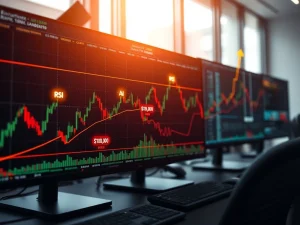Urgent: Bitcoin Price Faces Dire Threat as Investors Seek Safer Assets, $108K Drop Looms

The cryptocurrency market often reacts to global economic shifts. Recently, the Bitcoin price has experienced significant pressure. Investors are increasingly moving towards traditional ‘safer’ assets. This shift raises concerns about Bitcoin’s immediate future. Could BTC drop to $108,000? We explore the factors driving this trend.
Investor Sentiment Shifts Amid Economic Uncertainty
Market participants are growing cautious. Weak economic data from the United States sparked a flight to safety. This move has redirected capital from riskier assets like Bitcoin. Instead, investors now favor government bonds and gold. Gold, for instance, recently hit an all-time high. This surge clearly signals mounting recession fears. Such fears increasingly dominate overall investor sentiment.
Interestingly, equities reacted differently. Stock markets showed positive responses. Many market participants grew more confident about a potential US Federal Reserve interest rate cut. Cryptocurrencies, however, faced renewed pressure. Bitcoin briefly traded under $110,000. Unlike digital assets, stocks often benefit directly from lower financing costs. Reduced household debt burdens can also stimulate consumption, boosting stock performance.
Decoding the Federal Reserve’s Next Move
Recent economic indicators heavily influence central bank policy. Yields on the 2-year US Treasury dropped to 3.60%. This marks their lowest level in four months. It shows investors’ willingness to accept lower returns for greater safety. Demand surged after ADP’s Thursday report. US private payrolls added only 54,000 positions in August. This figure represents a sharp decline from July’s 106,000. The Institute for Supply Management (ISM) also reported a contraction in overall employment.
Consensus around the upcoming Sept. 16-17 Federal Open Market Committee (FOMC) meeting points to a 0.25% Fed rate cut. This would bring the benchmark down to 4.25%. Still, investors remain skeptical. They question whether the Federal Reserve can sustain such easing for an extended period. The CME FedWatch tool provides crucial insights. It indicates that traders expecting January 2026 rates at 3.75% or lower declined. This figure dropped to 65% from 72% a month ago. This gauge uses Fed Funds futures prices. It calculates implied probabilities ahead of the Fed’s Jan. 28 meeting. Friday’s US Bureau of Labor Statistics report will guide positioning across risk assets.

Why “Safer Assets” Attract Capital Now
The current economic climate drives investors to seek refuge. Government bonds, especially short-term Treasurys, offer stability. Gold has long served as a traditional hedge against inflation and economic uncertainty. These instruments become highly attractive during periods of high risk aversion. Investors prioritize capital preservation over potential high returns. This dynamic directly impacts volatile assets like cryptocurrencies. Consequently, the demand for safer assets surges. This limits Bitcoin’s ability to sustain bullish momentum.
An eventual rise in inflationary pressure could undermine economic growth. This risk is particularly salient with higher import tariffs in place. So, while lower interest rates may offer short-term relief, strong demand for gold and short-term bonds highlights persistent risk aversion. This situation could weigh heavily on cryptocurrencies. Market participants are clearly signaling their preference for security. They are less willing to take on additional risk.
Bitcoin’s Persistent Market Analysis and Correlation
A comprehensive market analysis reveals Bitcoin’s strong ties to traditional markets. Nasdaq’s 60-day correlation with Bitcoin currently sits at 72%. This high correlation indicates that the two assets have largely moved together. When tech stocks face headwinds, Bitcoin often follows suit. This linkage challenges the narrative of Bitcoin as a completely uncorrelated asset. However, structural catalysts could shift this sentiment. Some analysts highlight the potential addition of MicroStrategy (MSTR) to the S&P 500. Meryem Habibi, chief revenue officer at Bitpace, notes this inclusion “cements the legitimacy of an entire asset class.” Such a move would compel index funds and exchange-traded funds (ETFs) tracking the S&P 500 to purchase MSTR shares. This could introduce significant institutional capital to a company with substantial Bitcoin holdings.

The Road Ahead: Navigating Bitcoin Price Volatility
Even with elevated demand for US government bonds, fiscal imbalances could erode confidence in the domestic currency. This scenario has historically proven favorable for Bitcoin. Bank of America analysts reportedly project the euro will strengthen against the US dollar by 2026. They cite trade frictions and weakening institutional credibility. Such a shift could indirectly benefit Bitcoin as an alternative store of value. However, in the short term, risk aversion may push the Bitcoin price to retest the $108,000 mark. This level represents a critical support zone for the digital asset. Traders and investors should watch this level closely.
The growing demand for short-term Treasurys alone should not be viewed as a long-term bearish signal. It reflects immediate economic concerns and risk management strategies. Bitcoin’s long-term value proposition, including its scarcity and decentralized nature, remains intact. Therefore, while short-term volatility persists, the fundamental drivers for Bitcoin’s adoption continue to evolve. Investors must balance immediate market reactions with broader, long-term trends.

This article is for general information purposes and is not intended to be and should not be taken as legal or investment advice. The views, thoughts, and opinions expressed here are the author’s alone and do not necessarily reflect or represent the views and opinions of Crypto News Insights.









